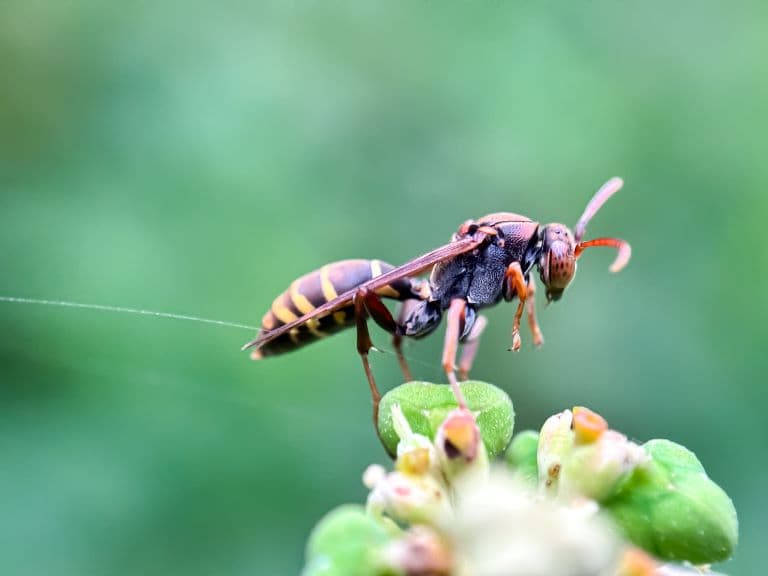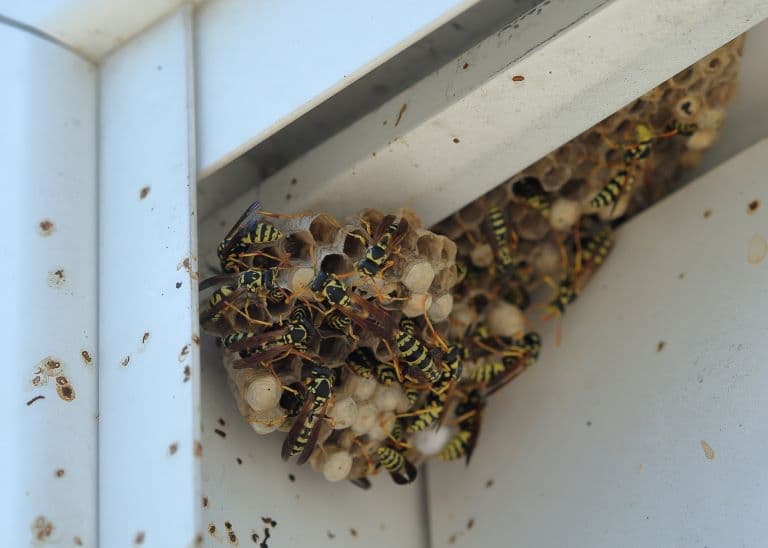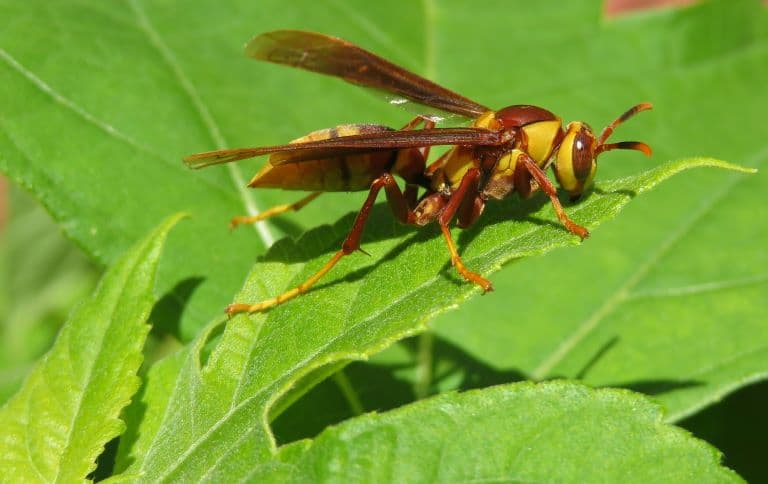Wasp Profile
Around 240 million years ago, the first dinosaurs appear in the fossil record. And honestly, they stole the thunder from pretty much everything else until their extinction a mere 66 million years ago.
But it was at this time that the much smaller Hymenopterans started shaking things up, too.
From this order emerged what today makes up possibly one million species of insect responsible for the critical ecosystem roles of pollination, pest control, parasitism and immeasurable biomass for larger animals to snack on.
These tasks tend to go unacknowledged by us, and the entire clade of a hundred thousand species is indignantly dismissed, simply because of a single bad experience with one species that we accidentally sat on once.
And that is a shame because there is so much more to respect about wasps than there is to fear.

Wasp Facts Overview
| Habitat: | All terrestrial habitats except Antarctic |
| Location: | All continents except Antarctic |
| Lifespan: | From 2 months to 2 years |
| Size: | From less than 1mm to 12.5 centimetres (5 in) long |
| Weight: | Up to 28 g (1oz) |
| Colour: | Usually dark, reddish or black, sometimes blue or yellow-black |
| Diet: | Nectar, insects, fruit, |
| Predators: | Birds, bats, predatory insects, spiders, |
| Top Speed: | 40 kph (25 mph) |
| No. of Species: | Likely around 1 million |
| Conservation Status: | Least Concern to Critically Endangered (IUCN) |
Wasps are so diverse that in terms of ecosystem services, they do almost everything that needs doing in one form or another.
They are a paraphyletic clade, which only increases their diversity, and leads to them being some of the largest and smallest insects on Earth. They’re also some of the most ancient, giving rise to both ants and bees, yet outnumbering them both five-to-one in terms of species richness globally.
Wasps hunt, parasitise, pollinate and feed other organisms in their environment, and are therefore holding almost everything together.
They even provide us with a lot more good than harm, protecting various crops and flowers from pests that would otherwise reduce our yields.
Interesting Wasp Facts
1. They predate ants
Figuring out insect taxonomy from fossils older than the dinosaurs is rather tricky, but there are several groups of geniuses with nothing better to do that are working diligently on this.
Wasps appear to emerge around 240 million years ago, about 140 million years before ants do. And while wasps as a group are paraphyletic (meaning, they aren’t a discrete category and have varying degrees of relatedness to one another), many of the earliest appear to be the ancestors of modern-day ants.
Interestingly, bees seem to be more closely related to ants than the common social wasps we’re familiar with, and groups like the mud dauber wasps (the ones often seen dangling their yellow, stripy legs beneath them while carrying mud balls to make their nests with) seem to be closer to ants than some of the social wasps.
Regardless, wasps probably came long before ants and likely started this whole colony animal thing that and took and ran with. 1
2. They are diverse
There are over 100,000 species thought to exist in the Ichneumonidae family of wasps, which represents the most diverse of the dozens of families described so far. This family is thought to have more species in it than all the mammals and birds on Earth combined.
And this is just one family. Some estimates have the total species richness of wasp kind at a million species, making them unfathomably diverse. Parasitoid wasps alone are thought to make up 350,000 species at least.
As you can imagine, 100,000,000 species of paraphyletic insects allow for a wide range of niches to be exploited, and wasps do this tremendously.
For perspective, there are up to 20,000 species of ant described, and roughly the same number of bee species, so wasps number fifty times that of either (though it’s likely there will be a lot more bee species that have yet to be described).
Contrary to our common perception of wasps as the paper nest-building yellowjacket social butt-stingers, the vast majority of wasp species are solitary. Females make a nest alone, lay eggs in it alone, and do little if anything to look after the swelling larvae that come out of them.
Curiously, some solitary wasps build communal nests, in which several other solitary wasps will join and breed.
This isn’t exactly a social behaviour – rather, it’s a community of solitary wasps sharing a space, because there is no division of labour – but it might represent a bit of a transitional behaviour between solitary and social behaviour. 2 3

3. They’re nectar-feeders
Another misconception is the idea that wasps are relentless hunters of people sitting in the grass. Most species of wasp actually feed on nectar, and many have specialised mouthparts for this purpose.
Even hornets and other large wasps, known to be ferocious killers of other insects, do so to feed their wriggly little babies. The adults themselves feed on nectar. And this plays a key role in eusocial wasp societies.
The heaviest wasp, the Asian hornet, visits at least 27 species of floral plants to make up its daily diet, but this may be a little misleading.
Adult wasps feed on nectar, but their young need more protein than you can squeeze out of a flower, so they’re often fed on the dead or paralysed bodies of other animals.
4. This process underpins sociality
For the solitary wasps, bringing the larvae these corpses is about the most they’re going to do for their young, but social wasps like hornets have been discovered to engage in an intricate nutrient exchange process with their young.
Nutrients brought to the larvae are excreted by the larvae and then fed upon again by the adult wasps.
It’s thought that this strange interplay contributes to social cohesion within the colonies, and represents a mutually beneficial relationship in which the gut flora of the larva helps supplement the nutrition of the adult by digesting proteins that mature wasps can’t break down.
The consequential co-dependency necessitates the colony dynamic and has resulted in some of the most infamous insect societies we know of.
5. They’re Pollinators
All this nectar-feeding plays a principal ecological role in the community: it leads to the pollination of innumerable plant flowers.
Figs are a great example, with at least 1000 species of fig relying on wasps for their pollination. More than 100 species of orchid are in the same boat, and any number of other plants have evolved to specifically target wasps as their mode of pollination.
So, without wasps, we will be short thousands of species of plants. 4

6. They’re parasitoids
Of the majority of wasps that are solitary, the majority of these are parasitoids. These parasitoids are also extremely diverse and occupy a wide range of habitats worldwide.
In most cases, they would lay their eggs inside a live animal such as a caterpillar or spider. By definition, the host remains alive until the lava hatch and devours it.
This can happen in free-roaming hosts or, as often the case, hosts who have been paralysed and then carried off to a secluded location such as a burrow or a mud nest.
Many wasps are highly specialised to a specific host such as the tarantula hawk wasp or the ichneumon wasp who can penetrate deep into a plant’s woody core to access boring larvae within it.
Parasitoids are defined by the fact that their hosts always die. But there are also many species of wasps that are true parasites.
7. They’re parasites
Cuckoo wasps are metallic, small wasps that find and invade the constructed nests of other species of wasp.
Within these nests are the paralysed hosts of the solitary was that built them. Cuckoo wasps will lay their eggs on these hosts and often their larvae will consume both the host and the lava of the solitary wasp.
8. They’re predators
And of course, there are the species who are just plain killers. There are around 1,100 species was in the subfamily known as the beewolves. These honeybee hunters go on rampages, destroying suede of honeybees to take home to their buried larvae.
There is of course an overlap between the parasitoid and the predator wasps in both hunt and kill their target animals. Regardless of their specific strategy, all of this killing is factored into a balanced ecosystem and plays an important role.
9. They can dive
And if you thought you could retreat to the water to avoid them, there is even a species that has been witnessed chasing its prey beneath the surface of a pond.
A new species of Microgaster wasp, legitimately named Godzilla, has been recorded on video following a caterpillar beneath the surface, chasing it back up to the top, and then laying eggs inside it.
10. They’re pest control
Being such accomplished killers, many species of wasps make excellent pest control for gardens or agriculture. Before chemical pasta science was readily available, wasp species were introduced commercially as a biological control, especially for types of white fly.
Chemical pesticides are now gaining notoriety for the destruction that they rain down on our environment, and so wasps are back in the spotlight.
Tomatoes, cucumbers, aubergine, marigolds, and strawberries, are all examples of commercial plants that often have wasps as their protectors.
But as responsible members of their ecosystems, wasps are far more than predators and pollinators.

11. They’re also prey
The sheer number of wasps buzzing around all over the place is bound to result in a few animals who have adapted to feed on them.
Many bird species, such as bee-eaters and buzzards readily feed on stinging insects including wasps. Even the formidable tarantula hawk wasp has a sworn enemy in the form of a roadrunner. Bullfrogs, notorious for being able to eat anything, will also happily go down an enormous wasp-like this.
So, wasps provide a substantial proportion of the biomass that makes the diet of larger animals.
12. They can make honey
One of the key arguments that people make in favour of bees over wasps use the social service they provide to humanity by way of honey.
But there are even wasps who can do this too. The appropriately named wasps live in colonies and make paper nests in the trees of Central and South America. They eat a mix of insects and nectar the latter of which is condensed within the nest in some species into wasp honey.
Unfortunately for humanity, this honey is fiercely guarded and small in amount when compared to the yield of the honeybee. As a result is not commercially available and not all that popular.
One species in this genus is even found in North America and is known as the Mexican honey wasp. While not widely recognised as a food source, it is considered a delicacy in some cultures in Mexico.
But more commonly, this species is used as pest control and as a pollinator for avocados.
13. They are the smallest flying insects
One of the chunkiest wasps is the Asian giant hornet. This beast can weigh up to 28 g and sounds like a petrol lawnmower. But it isn’t the largest, despite what Google will try to tell you.
That accolade likely goes to one of the tarantula hawk wasps, which can grow to at least 12 cm long, and scurry around in the undergrowth like a mouse with a hankering for spider guts. Or it could go to one species of Ichneumon wasp, whose ovipositor alone is almost 20cm long.
But it’s easy to forget, when looking at the largest, the wasps are also some of the smallest insects in the world. A fairly new genus of wasp from a group of wasps known as fairy flies has been measured at a mere 158 µm long.
This is now the record for the smallest winged insect, yet another medal for wasp kind.
14. They’re pretty chill
This one might be the hardest to convince people of, but try to approach it with a mind free from fear. Wasp stings can be really painful, and in some very rare cases of allergic reaction, even fatal.
But there are possibly 100,000,000 species of wasps ranging from a few microns to several inches long. They occupy every habitat, always with multiple species sharing the same space.
With numbers like this, it’s no wonder humans and wasps sometimes step on one another’s toes, but it also means that stings must be incredibly rare. And despite common myths, there is no species of wasp that’s out to get you.
In fact, most species of wasps are so docile you can even pick them up – this is especially true when they’re away from the nest and not in protection mode, but even then, most of the commonest species can even be hand-fed if you bribe them a little with some honey.
Wasp Fact-File Summary
Scientific Classification
| Kingdom: | Animalia |
| Phylum: | Arthropoda |
| Class: | Insecta |
| Order: | Hymenoptera |
| Clade: | Unicalcarida |
| Sub: | Apocrita |
Fact Sources & References
- Dmitry E. Shcherbakov (2013), “Permian ancestors of Hymenoptera and Raphidioptera”, ZooKeys.
- Thomas E Saunders (2018), “Variation in the diversity and richness of parasitoid wasps based on sampling effort”, PubMed Centra.
- “Key to Ants’ Evolution May Have Started With a Wasp”, New York Times.
- Aptive Environmental (2020), “Do Wasps Pollinate Plants?”, aptive.
